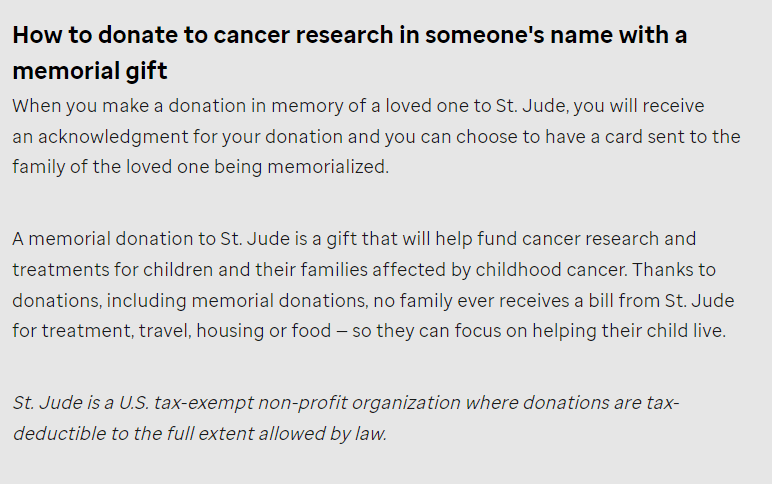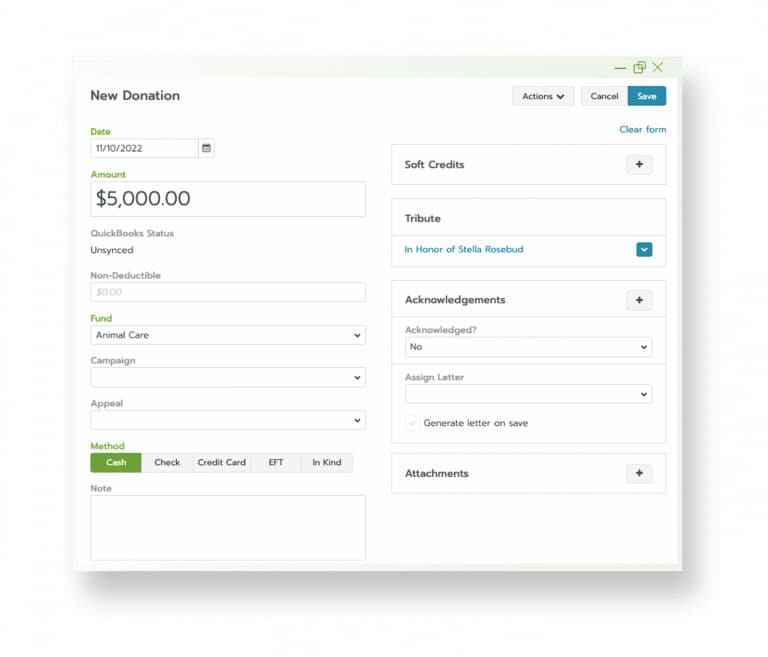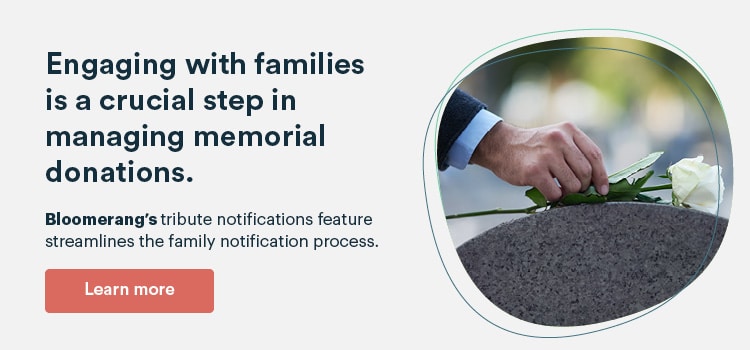In-Memory Gifts or Memorial Donations

After someone dies, their loved ones may be motivated to honor their memory. Memorial donations offer a way for families to carry on their loved ones’ positive legacy.
When your nonprofit manages memorial donations respectfully and efficiently, you can create a better experience for donors and families and grow your memorial giving program.
In this post, we’ll review the basics of how to manage and enhance your memorial donation program. We’ll cover:
- What is an in-memory or memorial gift?
- How to manage memorial donations
- Tips for showing gratitude for memorial donations
- How to write a memorial donation letter to family members
As you engage memorial donors and family members with consideration and compassion, you can build strong relationships with these individuals and foster ongoing engagement.
What is an in-memory or memorial gift?
An “in memory of” or memorial gift is a donation made after someone passes to memorialize their life. Many people donate to charity in their loved one’s name or ask that a gift be made in lieu of flowers.
Memorial gifts are usually made to nonprofits for one of two reasons:
- The nonprofit of choice is one that person who passed away supported or was deeply involved with during their life. Perhaps they volunteered there or donated money to the cause.
- The issue the nonprofit fights against was a factor in how the person died. For example, the family of someone who died of cancer might make a memorial gift to a cancer research organization.
Memorial gifts allow families to remember their loved ones and pay tribute to them while helping the deceased’s legacy live on through a meaningful contribution to a good cause.
How to manage memorial donations
Since memorial gifts are typically made in the wake of loss, your nonprofit should take care to manage these donations with extra care and consideration. Use these tips to craft a respectful memorial donation program:
Create a memorial donation information page
Your nonprofit’s website should offer comprehensive information about how to make memorial donations. This makes it much easier for families to get involved and start encouraging people to make in-memory gifts.
For example, the Susan G. Komen memorial giving webpage offers robust information about contributing memorial donations, creating memorial-giving pages and donating in honor of someone who is fighting breast cancer.

Your memorial giving page should similarly highlight direct donation opportunities or peer-to-peer fundraising opportunities that allow families to create their own donation pages.
The more you can promote your memorial donation opportunities, the more families and donors will be likely to get involved in these opportunities. Cross-promote your information page using your social media and email newsletter to spread the word even further.
Clearly explain how memorial donations will be used
Letting memorial donors know how your organization will use their gifts can be a powerful way to show them the continuing positive impact that their loved one will have on your mission.
Use your memorial giving information page and donation form to highlight who will be helped by donors’ gifts. For example, St. Jude’s memorial donation page explains that donors’ gifts ensure that “no family ever receives a bill from St. Jude for treatment, travel, housing or food — so they can focus on helping their child live.”

Track memorial donations using your donor management system
As you receive memorial donations, you’ll need to keep track of donors’ names, contact information and who they’re donating in memory of. This allows you to notify families of everyone who is giving in memory of their loved one.
The right donor management software can greatly simplify this process, automatically tracking donor and family relationships and syncing information from your online giving form into your donor management system.
Tips for showing gratitude for memorial donations
Stewarding memorial donors starts with showing them your appreciation. They’ve not only taken the time to support your nonprofit, but they’re also helping to honor the memory of someone who has passed. Your donor thank you letters should recognize the gravity of their gift and the positive impact of the person they’re memorializing.
Keep these tips in mind when drafting thank you letters for memorial donors:
Personalize the thank you letters
Add the donor’s name, donation amount and date of the donation to personalize your message. In addition, memorialize the deceased by including their name and describing their impact on your organization’s cause. For instance, if the individual volunteered with your organization, spotlight specific projects or programs they contributed to and what their role was.
Be respectful of the situation
Many donors may be unfamiliar with your nonprofit and the main reason they’re donating is to memorialize the person who passed away. Avoid overwhelming them with tons of additional information about your cause — keep your thank you letters focused on the legacy of the person who passed.
In addition, make sure your follow-up cadence for memorial donors is different from the steps you take for other types of donors. Again, these donors might not have a personal affinity for your cause or a strong desire to learn about your mission at the present moment. Keep your follow-up communications limited and respectful. You can send a message on the anniversary of the memorial donation to reiterate your gratitude and provide a brief update on your organization’s activities.
Let donors add a personal message
In a situation where the family asks for donations instead of flowers, it might be appropriate to give the donor a way to let the family know that the gift was made. In this case, you might want to allow donors to add their own personal message to the family that is sent through your program.
How to write a memorial donation letter to family members
In addition to thanking memorial donors, you should also create a plan for staying in touch with family members of the deceased and letting them know who has donated in memory of their loved one. Keeping families in the loop shows them the positive impact their loved one has had on your mission. Plus, it provides a way for families to reach out and thank donors themselves.
Reference these best practices when writing a memorial notification letter:
Keep the letter brief
The period after someone dies can be very difficult, and family members won’t have a lot of time to devote to corresponding with your nonprofit. Keep your memorial notification letters concise and to the point. Don’t discuss multiple aspects of your nonprofit’s mission — the letter’s content should focus on recapping the memorial donations you’ve received and expressing your support for the family.
Lead with your condolences
Remember that people are grieving and always keep that at the forefront of your communications. Give families your sincere condolences for the loss they’ve experienced. Also, let them know about the good the gift is doing and how their loved one is still making a difference through their legacy.
Provide a clear list of donor names and contact information
Let families know the names of donors who’ve given in memory of their loved one and any contact information the donors provided (whether phone numbers or email addresses). This gives families a convenient resource to use if they want to follow up with personal thank you messages. However, let families know that your nonprofit has already thanked donors as well.
Highlight the impact of memorial gifts
When communicating the impact of memorial donations, be specific about how the donations you’ve received will further your cause. For example, you might say “Because of the thousands of dollars we received in memorial gifts made in memory of your loved one, three families will have access to a month of free housing while their children receive medical care.”
Use software to streamline the family notification process
As mentioned, robust donor management software can make the memorial donation notification process a lot simpler by automatically tracking relationships between donors and families.
For example, Bloomerang’s tribute notifications feature saves time by automatically syncing donor and family relationships and tracking which families have already been notified about memorial donations. Plus, you can use this feature to draft a memorial donation notification letter and customize it to ensure each family receives a personalized message.

The bottom line
When someone dies, the grieving process can be difficult for their family and friends. Knowing that their loved one is being memorialized and is continuing to make a difference in the world through a memorial gift can be a great source of comfort during this time.
By managing memorial donations respectfully and efficiently, you can form better relationships with donors and families, providing greater support during a challenging time.

